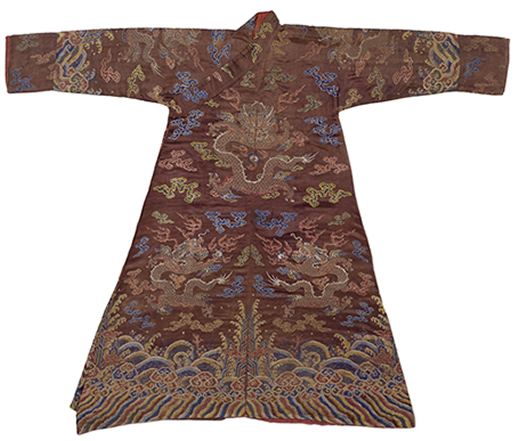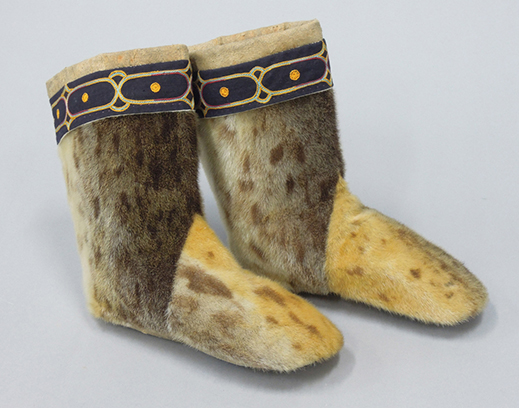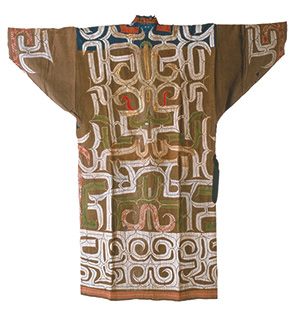 |
Focus features two in-depth reviews each month of fine art, architecture and design exhibitions and events at art museums, galleries and alternative spaces around Japan. The contributors are non-Japanese art critics living in Japan. |
|
|
 |
 |
 |
The Land to the North: Paintings of Ainu in the Edo Period
Michael Pronko |
 |
This vivid portrait of the Ainu chieftain Tsukinoe shows a mix of Chinese, Russian, and Ainu clothing, as well as the long beard, curly head hair, and extensive body hair notable in all of the portraits. Many of the chieftains are shown barefoot, perhaps to lend an air of primitive otherness, but Tsukinoe has boots on here. Tsukinoe, Ainu Chieftain of Kunashiri, Ishuretsuzo painting by Hakyo Kakizaki, 1790. Courtesy of the Besançon Museum of Fine Arts and Archaeology, France |
|
Another chieftain, Shimochi, is posed as if hunting. Note the small bow and arrows, with some stuck into his thick hair. The distinct leg muscles and leggings, as well as the earrings, seem painted purposefully to highlight the disparity with Japanese portraits of the time. Shimochi, Ainu Chieftain of Akkeshi, Ishuretsuzo painting by Hakyo Kakizaki, 1790. Courtesy of the Besançon Museum of Fine Arts and Archaeology, France |
The history of Hokkaido is about as violent as that of the rest of Japan. In 1789 an uprising at a trading post by Ainu, the indigenous people of the island, against oppressive Japanese merchants and rulers was brutally suppressed and the instigators were executed. The incident, known as the Menashi-Kunashir Rebellion, was commemorated by a series of rare paintings made of Ainu chieftains who collaborated with the Japanese against the rebels. These 12 spectacular portraits form the core of a special exhibition of Ishuretsuzo, or images of Ainu, at the National Museum of Japanese History in Sakura, a city not far from Narita Airport.
At the end of the 18th century, the concept of Japan did not yet include Hokkaido. Ezo, as the Japanese called the island to the north, was a place populated by non-Japanese. This was when Hakyo Kakizaki (1764-1826), a samurai artist in the service of the allegedly more advanced Edo Shogunate, ventured to Hokkaido to paint portraits of the most influential members of the alien culture that dwelled there -- the Ainu. The exhibition supplements these portraits with drawings, sketches, objects and documents from the same period.
 |
|
A very Chinese-looking brocade robe that may have been typical of the wardrobe of Ezo chieftains of the day, indicating the extent of trade with cultures other than those ruled by the Edo Shogunate of the late 1800s. Courtesy of the National Museum of Japanese History |
Kakizaki's paintings of Ainu chieftains are on loan from the Museum of Fine Arts and Archeology in Besançon, France, where they were discovered in the museum's archives only in 1984. Other works on display come from the National Museum of Japanese History, the Hakodate City Museum, the Hokkaido Museum, and the National Museum of Ethnology. With the collaboration of the latter two institutions, the National Museum of Japanese History has put together an impressive special exhibition of Ishuretsuzo paintings, maps and ethnological objects from the Ezo region.
The three rooms devoted to the show offer a rare chance to see how Edo-period artists viewed the Ainu people. It may seem slightly odd to commemorate the violent suppression of rebels with portraits of survivors, but the paintings powerfully illustrate how different the Ainu were from the Japanese in their culture and way of life. They were indeed alien, with earrings, body hair, body sizes and postures dramatically unlike those of the Japanese.
Also striking is how internationalized Hokkaido already was back then. Contact with Chinese, Russians and Japanese was commonplace, though many of these encounters involved combat and theft as much as trade and cultural exchange. Though the artists, and their patrons, may have asked the chieftains to dress up just to have their portraits painted, these images accurately capture the exotic mix of Russian braids, Chinese silk robes, and sea otter and bear pelts worn by Ainu at the time.
 |
|
|
|
A perfectly preserved pair of sealskin boots. These were common among the Ezo Ainu, who may have obtained them through trading with Kuril Ainu or other ethnic groups from Sakhalin Island. Courtesy of the National Museum of Ethnology |
These depictions of Ainu clothes, tools, weapons, and physical characteristics are priceless ethnographic materials, but they are also superb art. The facial expressions, eye shape, and poses of the subjects are quite distinct from those seen in Edo-period portraits of Japanese. Of course, their hirsuteness, long beards, and size are obvious physical differences, but the paintings also convey the unique presence of the Ainu chieftains. They look as fierce as any warrior, yet less stiff and formal than Japanese warriors as portrayed in those days.
Many of the paintings have the chieftains hunting, walking with odd-looking animals, or posing with weapons. Those compositions emphasize how foreign to the Japanese the Ainu were, and how “the other” was perceived by Edo-era artists. The earrings, leggings, weapons, and even the dogs they led around all identify them as unequivocally non-Japanese, and through this contrast serve to define what is Japanese as well.
The show includes helpful reproductions and close-ups that point out many details that might otherwise be missed, as well as preliminary sketches made for the paintings, plus scrolls with descriptions and stories about the Ainu. Also on display are some fascinating and richly colored maps, together with decorative clothes and jewelry, as well as weapons and hunting implements. Particularly intriguing are the small-sized bows and arrows for hunting birds and small animals, rendered vividly by the artists.
 |
|
 |
|
A necklace of the type seen in some of the portraits and sketches in the exhibition reveals elements of ancient design in its simplicity, robustness and power.
Tangible Folk Cultural Property, courtesy of the Hakodate City Museum |
|
A cotton robe with a more traditional Ainu design was often worn together with Chinese-style silk robes, at least in these portraits. Courtesy of the Hokkaido Museum |
The exhibition demonstrates that there was a great deal of interaction among the peoples populating these northern lands, extending from Hokkaido to the islands further north and across the strait to what is now Russia and China. Indeed, it points to the likelihood that during the Edo period, at least, the Ainu had more contact with Russian and Chinese cultures in the north than with Japanese culture to the south.
The museum is complementing this special show with some equally fascinating exhibits on other facets of Ainu life. Videos of dances, ceremonies, daily activities, and other aspects of Ainu culture offer an excellent follow-up to the Ishuretsuzo exhibition. Together these materials provide a comprehensive portrait of the indigenous culture of Hokkaido and are well worth checking out during or after one's tour of the main exhibition rooms. Wander out to see the cultural exhibits and then wander back to the paintings to get a sense of the compelling interplay of art, history and culture represented by this important, and often overlooked, part of the world's artistic heritage.
 |
| | Ishuretsuzo, the Image of Ezo: Tracing Persons, Things and the World |
| | National Museum of Japanese History |
| | 15 December 2015 - 7 February 2016 |
| |
117 Jonai-cho, Sakura City, Chiba Prefecture
Phone: 043-486-0123
Hours: 9:30 to 16:30 (last entry at 16:00); closed Mondays
Access: From Sakura Station on the JR Sobu Line it is 15 minutes by bus, though a taxi is recommended. From Keisei-Sakura Station on the Keisei Line, it is five minutes by taxi or 15 minutes on foot. Both stations are about one hour from downtown Tokyo and 25 minutes from Narita Airport. |
|
 |
 |
Michael Pronko
Michael Pronko teaches American literature, film, art and music at Meiji Gakuin University. He has appeared on NHK, Sekai Ichiban Uketai Jugyo, and other TV programs. His publications include several textbooks and three collections of essays about Tokyo. He writes regular columns for Newsweek Japan, ST Shukan, The Japan Times, and for his own websites, Jazz in Japan and Essays on English in Japan. |
|
 |
|